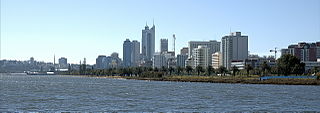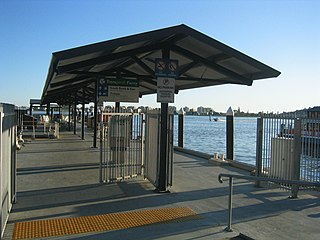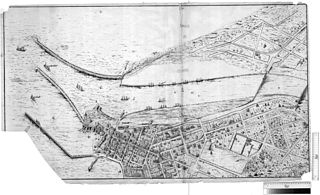
The Swan River is a major river in the southwest of Western Australia. The river runs through the metropolitan area of Perth, Western Australia's capital and largest city.

Heirisson Island is an island in the Swan River in Western Australia at the eastern end of Perth Water, between the suburbs of East Perth and Victoria Park. It occupies an area of 285600 m2, and is connected to the two foreshores by The Causeway. The next upstream island is Kuljak Island, then Ron Courtney Island, with no islands in the Swan River downstream between Heirisson Island and the Indian Ocean other than the artificial islet in Elizabeth Quay.
The Swan Brewery is a brewing company, whose high profile brewery was once located beside the Swan River, in Perth, Western Australia.
The Swan Bells are a set of 18 bells hanging in a specially built 82.5-metre-high (271 ft) copper and glass campanile in Perth, Western Australia. The tower is commonly known as The Bell Tower or the Swan Bell Tower.

Perth Water is a section of the Swan River on the southern edge of the central business district of Perth, Western Australia. It is between the Causeway to the east, and Narrows Bridge to the west – a large wide but shallow section of river, and the northern edge of the suburb South Perth. It is considered a landmark of the City of Perth.

The Causeway is an arterial traffic crossing in Perth, Western Australia, linking the inner-city suburbs of East Perth and Victoria Park. It is carried over the Swan River at the eastern end of Perth Water by two bridges on either side of Heirisson Island. The current Causeway is the third structure to have been built across the river at this point.

Barrack Square is an open public square on the foreshore of Perth Water on the Swan River, located at the southern end of Barrack Street near the central business district of Perth, Western Australia.

South Perth is a residential suburb of Perth, Western Australia that adjoins the southern shore of Perth Water on the Swan River; it is 3 kilometres (2 mi) south of the central business district. The suburb adjoins two major arterial roads—Canning Highway and the Kwinana Freeway, and is within the City of South Perth local government area.
Perth is the capital city of Western Australia. It was established by Britain as the Swan River Colony in 1829. The area had been explored by Europeans as early as 1697, and occupied by the Indigenous Whadjuk Noongar people for millennia.

Barrack Street Jetty is located on the edge of Perth Water on the Swan River in Perth, Western Australia. It is no longer used on the Transperth ferry service between the Perth central business district and South Perth, having been replaced on that service with Elizabeth Quay Jetty.

Fremantle Harbour is Western Australia's largest and busiest general cargo port and an important historical site. The inner harbour handles a large volume of sea containers, vehicle imports and livestock exports, cruise shipping and naval visits, and operates 24 hours a day. It is located adjacent to the city of Fremantle, in the Perth metropolitan region.
MV Perth is a wooden boat that has operated on the Swan River in Perth, Western Australia. Built in Fremantle in 1914, it is one of the oldest wooden boats still afloat in Western Australia.

The north shore of Perth Water on the Swan River frontage to the city of Perth in Western Australia has been frequently changed since the arrival of Europeans in 1829. Various forms and structures have appeared and been removed over the last 190 years. Jetties, ports and various forms of reclamation have moved the shore considerably into Perth Water. The main eras of reclamation were in the 1870s, 1900s, 1920s-1937, 1955–1959, and 1967.

Riverside Drive in Perth, Western Australia, is a road on the northern side of Perth Water. It was built on reclaimed land in the 1930s, and links The Causeway to the Narrows Bridge.

Elizabeth Quay is a mixed-use development project in the Perth central business district. Encompassing an area located on the north shore of Perth Water near the landmark Swan Bells, the precinct was named in honour of Queen Elizabeth II during her Diamond Jubilee.

Victoria Quay is a wharf on the south bank of the Swan River mouth in the Western Australian port city of Fremantle. It is separated from the Fremantle CBD by the railway line. Originally named South Quay, it was renamed Victoria Quay on 26 July 1901 in honour of the late Queen Victoria. With North Quay it forms the Inner Harbour area of Fremantle Harbour.

Customs House and former Falk & Company Warehouse is an historic three-storey brick building located in Fremantle, Western Australia. The building has a number of prominent ornate façades on Phillimore Street between Henry and Pakenham Streets. It houses the Fremantle regional office of the Australian Customs and Border Protection Service, Centrelink, and a number of other Australian Government offices.

Esplanade Park is a public reserve in Fremantle, Western Australia. Situated on Marine Terrace and opposite the Esplanade Hotel, the reserve features about 100 mature Norfolk Island pines and the Explorers' Monument.

Captain Cook Cruises is a cruise and ferry operator on the Swan River, Perth.

Rous Head is a reclaimed seabed area, which is utilised as a service industrial area. It includes a small harbour area that is located on the north side of the North Mole at Fremantle Harbour.















